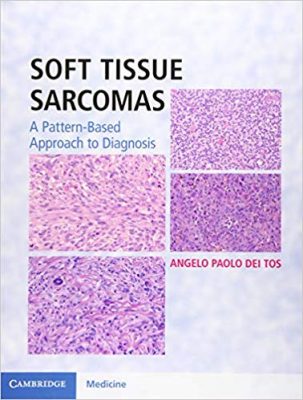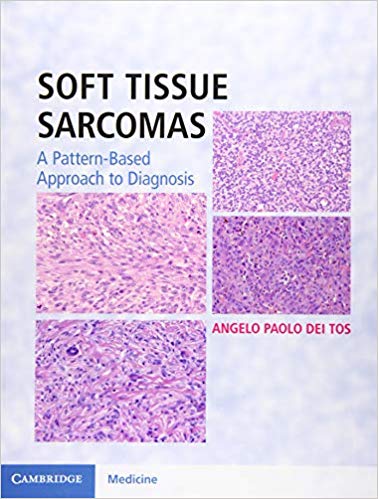 Editor: Angelo Paolo Dei Tos, MD
Editor: Angelo Paolo Dei Tos, MD
Publisher: Cambridge University Press – 600 pages
Book Review by: Sonu Chandiram
“To achieve sufficient diagnostic expertise is unavoidably difficult” in detecting soft tissue sarcomas, writes the author Dr. Angelo Paolo Dei Tos in the Preface to this book focused on using a pattern-based approach in diagnosing these types of tumors. Such an approach “allows us to narrow significantly the differential diagnoses and to guide rationally the choice of immunostains as well as of molecular tests.”
Dr. Tos points out that correct diagnosis of soft tissue tumors is one of the most challenging tasks in the field of oncologic diagnostic pathology. Diagnosing them correctly requires a ‘complex combination’ of:
- Morphologic observation
- Immunohistochemistry
- Molecular genetics
Accuracy of diagnosis of soft tissue sarcomas is also difficult because of the rarity of their incidence: only six cases out of every 100,000 in a year. The editor has organized the content of this book “according to the approach I use in my daily diagnostics” which includes consideration of “the shape of the cells, how they organize, and in which background they are set.”
To equip yourself to better diagnose soft tissue sarcomas, we urge you to browse the contents of each of the chapters of this textbook, then take a deep dive into the ones that contain coverage of the subjects and topics wherein you require more specific information and knowledge provided by the editor and the contributors who authored or coauthored the chapters named below:
- Introduction
- Imaging of Tumors and Pseudo-tumors of Soft Tissues
- Principles of Local Therapy of Soft Tissue Neoplasms
- Medical Treatment of Adult Soft Tissues Sarcomas and Gastrointestinal Stromal Tumors
- Intermediate Malignant and Malignant Tumors of Soft Tissue Featuring Spindle Cell Morphology
- Soft Tissue sarcomas with Epithelioid Morphology
- Round Cell sarcomas
- Pleomorphic Sarcomas
- Myxoid Sarcomas
- Intermediate Malignant and Malignant Tumors of Soft Tissue Featuring an Inflammatory Background
- Intermediate Malignant and Malignant Tumors of Soft Tissue Resembling Normal Tissue
Let us take a look at one of tumors – synovial sarcoma – discussed in chapter 4 entitled Intermediate Malignant and Malignant Tumors of Soft Tissue Featuring a Spindle Cell Morphology authored by Dr. Marta Sbaraglia and the editor Dr. Tos. Turn to page 170 with the heading Synovial Sarcoma.
The organization of the contents of this ‘subchapter’ on synovial sarcoma, found on pages 170 through 180, consists of discussions of the following:
- Definition and Epidemiology
- Clinical Presentation and Outcome
- Morphology and Immunophenotype
- Genetics
- Differential Diagnosis
- Key Points in Synovial Sarcoma Diagnosis
What is noteworthy of this chapter, as with many others, is the presentation of a large number (20) of visuals – 18 micrographs, a full-color photo, and a box (Key Points) in just 11 pages. Smart editors understand the importance of presenting graphics in enabling readers to better absorb and retain material. Let’s take a couple of sample looks in two of the sections we have listed above, to get a better idea of how the discussions are written.
The Definition and Epidemiology section explains in a single paragraph that synovial sarcoma accounts for 15 percent of all soft tissue sarcomas, so readers come to know that this disease is not that rare. Also, while it can form at any age of a person, the peak incidence is between the first and third decade. An exception from the peak incidence was the actor Robert Urich who died of this disease at age 55.
In Clinical Presentation and Outcome, it is noted that most synovial sarcomas occur in the soft tissues of the lower extremities, especially around the knee and ankle, followed by the trunk, the head and the neck region (including the hypo-pharynx and the larynx) and the mediastinum. This disease also occurs in the lungs and pleura, in the gastrointestinal tract, and in the kidney
In summary, this is an excellent book for established practitioners, fellows, and medical residents intending to become specialists in this field, as it provides detailed strategies and methods in diagnosing soft tissue sarcomas.
Editor:
Angelo Paolo Dei Tos MD is Professor of Pathology at the University of Padua, Director of the Department of Pathology in Treviso, and Consultant Pathologist for orthopedic oncologic pathology at the Instituto Ortopedico in Rizzoli, Italy
Contributors:
Valerie Bousson MD, PhD, Paolo G. Casali MD, Marco Gambarotti MD, Alessandro Gronchi MD, Jean-Denis Laredo MD, Alberto Righi MD, Marta Sbaraglia MD, and Daniel Vanel MD.







